Volume 19 - 2010



Science, Scholarship &
the Arts at the University of North Texas
UNT Research Home | Studying Aircraft Fatigue
Mention the phrase “aircraft fatigue” to the typical weary traveler, and you’ll probably hear a story about long waits for takeoff or tiresome searches for lost luggage. But at the University of North Texas’ Institute for Science and Engineering Simulation, research on aircraft fatigue — a general term for failure of aircraft components under stress — will help the U.S. Air Force keep aging aircraft flight-worthy and may someday assist cost-strapped commercial airlines in maintaining their vast fleets.
Defense Department Support
ISES — an institute for characterization, simulation and modeling of aerospace components and materials — is led by principal investigator and director Rajarshi Banerjee, together with co-PIs Alan Needleman, Angela Wilson and Thomas Scharf. It works in close collaboration with the Center for Advanced Research and Technology (CART) and the Center for Advanced Scientific Computing and Modeling (CASCaM) at UNT.
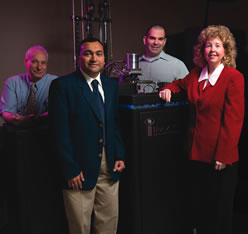
Researchers in UNT’s Institute for Science and Engineering Simulation — from left, Alan Needleman, Rajarshi Banerjee, Thomas Scharf and Angela Wilson — are helping the U.S. Air Force keep aging aircraft flight-worthy.
Photo by: Jonathan Reynolds
The institute is supported by more than $8.5 million in Department of Defense appropriations received in 2008 and 2009. It uses an abundant array of resources already existing at UNT, including a collection of high-powered microscopes at CART. Located at Discovery Park, UNT’s nearly 290-acre research park, these microscopes enable researchers to explore objects at the angstrom (one ten-billionth of a meter) level and actually see atoms within materials.
While the work is being funded by the Department of Defense, the research will be of interest to members of the aerospace industry and eventually could apply to commercial airlines.
“With wars in Iraq and Afghanistan, a great deal of stress is being placed on the country’s aircraft,” says Banerjee, an associate professor in the Department of Materials Science and Engineering whose work with U.S. Air Force researchers includes a previous grant from the Air Force Office of Scientific Research. “The research at UNT will help maintain and extend the life of aging aircraft, prevent catastrophic engine failure and aid the Air Force in developing better materials for the next generation of aircraft.”
CART and CASCaM
The research program has two parts, explains Banerjee: an experimental portion involving advanced characterization of aerospace materials using the unique, state-of-the-art facilities in CART, and a modeling and simulation portion that is exploring mechanisms associated with failure of aircraft components and parts. The experimental and modeling/simulation parts work synergistically under ISES.
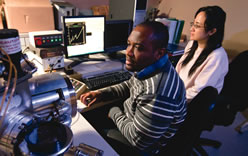
Materials science doctoral students Eric Osei-Yiadom and Fang-Ling Kuo work in the XPS/Auger microscopy lab at UNT’s Center for Advanced Research and Technology (CART). ISES researchers work in close collaboration with researchers at CART and extensively use its suite of advanced characterization and analysis instruments.
Photo by: Jonathan Reynolds
Banerjee and Scharf, who is an assistant professor of materials science and engineering and assistant director of CART, concentrate on characterization and analysis. Needleman and Wilson work closely with other researchers in CASCaM, approaching the work from the modeling and simulation perspective.
“I think this project is a nice example of the interaction between modeling and experiment, and between industry and academics,” says Needleman, professor of materials science and engineering and a member of the National Academy of Engineering and a recipient of the Prager Medal from the Society of Engineering Science and the Drucker Medal from the American Society of Mechanical Engineers. “It also takes advantage of some unique capabilities at UNT.”
Working with aircraft engine manufacturer Pratt & Whitney, Needleman is looking for ways to reduce the thickness of turbine blades, which will mean reduced engine weight and increased fuel efficiency, while avoiding “creep,” the slow deformation of blades under a constant load. Pratt & Whitney will carry out creep tests on specimens of turbine blade material of various thicknesses, then send the specimens to UNT to identify and characterize the mechanism responsible for the diminished creep life of thin blades.
“This will take advantage of the excellent materials characterization facilities and expertise at UNT,” Needleman says.
The program is the first manifestation of CART-CASCaM synergy and an opportunity to solve technical challenges of national importance, says Tom Cundari, co-director of CASCaM with Wilson, professor of chemistry.
What is ISES?
UNT’s Institute for Science and Engineering Simulation was created and funded by a congressional appropriation specifically to address issues of aging aircraft such as fatigue and other failure mechanisms of aircraft components, structures and materials. ISES collaborates closely with two centers at UNT: the Center for Advanced Research and Technology and the Center for Advanced Scientific Computing and Modeling. Through materials characterization, simulation and modeling, the researchers at ISES are providing U.S. Air Force scientists with the ability to test materials and components more safely, cheaply and quickly than is possible with traditional approaches.
“ISES is leveraging the capabilities of CART, CASCaM and a broad spectrum of departments in the College of Engineering and the College of Arts and Sciences,” says Rajarshi Banerjee, the principal investigator and director of the ISES program and an associate professor in the Department of Materials Science and Engineering.
“There are two things that are novel and thus exciting about the ISES project,” Cundari says. “First, there is the close interfacing of the experimental and characterization excellence of CART with the modeling and simulation excellence of CASCaM. CASCaM can use the experimental information CART provides to refine and improve our models — in other words, make the simulations more accurate. In turn, CART researchers can use the results of CASCaM simulations to better understand existing systems and as guidance in the design of new and improved aircraft materials.
“Second, CASCaM brings together in one place modeling and simulation experts who can study matter across different size regimes, from those who study the atomic and nano (one-billionth of a meter) level like Angela Wilson to those who model entire macro-level (visible to the eye) devices like Alan Needleman.”
From Meters to Angstroms
Banerjee cites the example of a turbine disc from a jet engine.
“Predicting how such a component will fail — how it will crack — is an involved problem. You need to understand things from the scale of the component down to atoms — from meters to angstroms. There’s a classical problem: How do you go from that disc down to the atom? This is a very important challenge both for the modeling and simulation community and for the characterization community.”
First, the disc is examined using the experimental tools and facilities of CART to try to understand the mechanisms that led to the failure of the component in as much detail as possible, possibly down to the atomic or angstrom scale. This is the characterization process.
“Then,” says Banerjee, “we tell the CASCaM people, ‘This is the way this component is failing.’ They build a computer model to try to reproduce this mechanism failure that was seen experimentally — to describe the physical reality of what is happening. Once they have done that, they say, ‘We know how this is failing. We can reproduce this in the computer. Can we use this computer model to predict when it is going to fail, under what conditions it will fail? Can we use this to develop something that will not fail?’”
The goal, Cundari says, is to develop and employ state-of-the-art modeling and simulation tools to study components from the atomic and nano levels on up to the actual devices.
Saving Time and Money
The advantage of this system, Banerjee says, is clear: “We save a lot of time and a lot of money. The old way of doing it goes something like this: I can characterize that failed component and find out what mechanism led to the failure, then I can just blindly say, ‘Maybe if I change my chemistry by a little bit, this would not happen.’ How would I know this? I’d go back and make a new component, test it in a lab, let it fail, then look at it. Did it work? Maybe, maybe not. Then it’s back to the drawing board.”
Coupling modeling and simulation, he explains, expedites the process substantially and reduces the cost significantly.
The priorities of the research are currently being worked out with the Air Force, but participants anticipate that they will examine failure both of jet engine components and of airframe components (those exclusive of the power-generating or propulsion system) that experience harsh operating conditions.
“We will work closely with researchers at the Air Force Research Laboratory and partners from industry and academia to identify the key issues,” says Banerjee. “Which are the critical needs and which of those match our expertise? We want to make sure we are contributing as effectively as possible.”
More Features
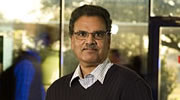
Net-Centric Computing
UNT leads NSF center creating cutting-edge software for complex networks.
By Sarah Bahari
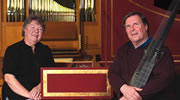
Handel Oratorios
Students in the early music program collaborate on musical masterpieces.
By Ellen Rossetti
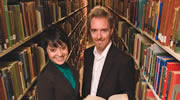
Fellowship Opportunities
Undergraduates experience the work of professional scholars with fellowship initiative.
By Nancy Kolsti
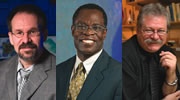
Computational Epidemiology
Researchers use high-performance computers to forecast disease outbreaks.
By Sarah Bahari
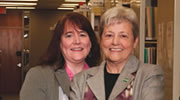
Digital Depository
Librarians harvest defunct government web sites for UNT’s CyberCemetery.
By Alyssa Yancey
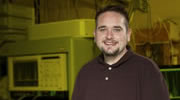
Microwave Spectroscopy
Instruments measure molecular fingerprints 1,000 times faster than before.
By Mellina Stucky
Departments
President's Note
"Leading the pack" for innovative changes
Initiatives
National research status, new senior faculty
Awards
Top engineers, chemists, Fulbright specialists
News Briefs
New clusters, plant defense, Nature research
Faculty Researchers
Experts in children’s issues, bioinformatics, interactive performing, mesoscale technology
Student Researchers
Exploring tribal archives, corporate fraud, nanoscale circuits, international politics
Faculty Books
Spanish language media, math, Arab art
End Note
Investing in research
Web page last updated or revised: January 27, 2010
Questions or comments about this web site? urcm@unt.edu
"University of North Texas," "UNT," "Discover the power of ideas" and their associated identity marks, as well as the eagle and talon graphic marks, are official trademarks of the University of North Texas; their use by others is legally restricted. If you have questions about using any of these marks, please contact the Division of University Relations, Communications and Marketing at (940) 565-2108 or e-mail branding@unt.edu.